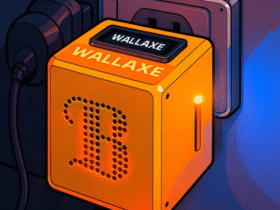Bitcoin (BTC) is going through one of its deepest corrections of the year, after falling more than 30% from the all-time high of $126,200 reached on October 6. The move has revived fears that a new bear market is forming. This, while technical, on-chain and institutional flow signals begin to align in that direction.
Venezuelan trader and investor Alberto Cárdenas told CriptoNoticias that the recent fall “is a sign of a turning point in the market.”
He explained that, being a drop of more than 20%, “we have probably made the top or ceiling in October and now we are going to a bitcoin bear market that can be extended until the entire year 2026 or at least until October 2026, according to the 4-year cycle of BTC.”
Cárdenas highlighted that the recent behavior of sales at a loss among the most short-term investors It coincides with typical dynamics that precede bitcoin bear markets.
«There was a movement of important liquidations, there was a lot of euphoria on the side of long positions, many people were liquidated in October and early November. “It is something typical of volatility and of those who leverage a lot in these phases,” he noted.
He added that this market purification, while reducing excessive leverage, also leaves many players out of demand. “Generating a negative signal,” he noted.
Key factors of a bitcoin bear market
To confirm a sustained bear market for bitcoin, Cárdenas considered it key to observe the selling volume, sentiment, flows of exchange-traded funds (ETFs) and the behavior of companies with large treasuries in bitcoin, such as Strategy.
In that sense, he warned that in recent weeks there has been an outflow of funds. “Which indicates that there is little appetite right now for bitcoin, for digital assets, and it is a bearish sign,” he warned.
«For me we are at the beginning of a bear market. We’re probably entering one. And it will be a trial by fire that will last until November of next year,” he predicted.


Even so, Cárdenas pointed out that This correction also opens opportunities.
This correction offers an opportunity to buy with a short-term horizon, as I think BTC can return to the $100,000 area. But it depends on the profile. For a long-term investor it is a much more attractive level than the one we had just 1 month ago. Those who do it in the long term understand that the asset can have volatilities greater than 50%.
Alberto Cárdenas, trader and investor.
«Bitcoin enters a delicate phase»
In a similar vein to that of Cárdenas, the analysts of the Arab Chain platform they claim that bitcoin enters a complex stage. One characterized by a significant reduction in sell-side liquidity.
According to that firm, “the total liquidity indicator on the sell side shows a decrease to approximately 975,000 bitcoin.” This shows that There are fewer coins available to be sold by active entities.
At the same time, they highlight that long-term accumulation continues to grow. “The Accumulator Address Demand indicator shows an increase of more than 355,000 bitcoin,” he points out. The above is a behavior that, the platform says, It is usually interpreted as constructive in broad horizons.
However, institutional demand operates in the opposite direction. Arab Chain highlight that “the significant drop in demand for ETFs to –51,000 bitcoin” reflects weakness among regulated investors.
Bitcoin buying impulse reduces
The platform adds that the net price-purchase correlation on Binance, the largest bitcoin exchange in the world, has weakened to approximately 0.72. This implies that the buying momentum has reduced, even when the price reached the support of USD 80,000.
«This reflects a weak real inflow of liquidity. Any selling pressure could trigger a rapid price correction,” they warn from Arab Chain. And they point out that the general picture combines “limited supply and clear long-term accumulation, offset by weak institutional demand and a decline in purchasing momentum.”
The above, leaving the future direction of the market subject to the recovery of purchasing power in the main liquidity pools.
The chart below shows how, as the price of bitcoin falls, sell-side liquidity decreases, accumulator demand increases, and ETF demand turns negative. This reflects a limited supply and a clear weakness in the inflow of institutional liquidity.


«The market is already operating in a bearish-like environment»
On the other hand, the CryptoQuant analyst known as CraZzyBlockk affirms that the data on unrealized gains and losses by age bands show “a clear change in the structure of the market.”
He highlights that new investors, especially those who hold bitcoin between 1 day and 1 month, present “deep unrealized losses.” Meanwhile, short-term holders—all with less than 6 months—are facing their most severe declines since the peak of the cycle. That places these cohorts “clearly in negative territory,” according to the specialist.
The analyst maintains that these conditions They often anticipate the early phases of bitcoin bear markets or cycle breaks.
“When these cohorts are lost together, the market typically enters a period in which any price recovery turns into outflow liquidity,” he notes. This, as sellers seek to reduce losses, which generates resistance at the levels where these groups averaged their entry cost.
The chart below shows how different cohorts of bitcoin holders are recording unrealized losses as the price falls. The colored bands reflect that short-term investors, especially those who hold BTC between one and 30 days, endure the deepest losses, while long-term holders exhibit more moderate variations.
The price line shows how each pullback intensifies the stress in recent groups, indicating a market dominated by selling pressure and bearish sentiment.


A bullish scenario that depends on short holders
CraZzyBlockk clarifies that there is still a bullish scenario. But it “largely depends” on the behavior of short-term holders (STH).
He thus explains that if STHs resist capitulation in unrealized losses of approximately 20% to 30%, “the market avoids the deep reset associated with full bear cycles.”
However, if these investors begin to aggressively take losses, “the market tends to prolong the decline until this group completely unravels.”
Using the current data, the analyst concludes that BTC “already operates in an environment similar to the bitcoin bear market, dominated by underwater short-term capital and emotionally charged supply.” The above, taking into account that the STH have fled the market in terror in recent days, as reported by CriptoNoticias.
Bitcoin is going through a crucial moment
Obviously, bitcoin is going through a crucial moment. The combination of falling price, weakening institutional demand, capitulation of short-term investors and adverse technical signals suggests that the asset faces an increasing risk of transitioning into a sustained bear market.
However, long-term accumulation remains active and some analysts remain optimistic and think that this is a correction within a broader cycle.
In either case, market evolution will depend on BTC’s ability to recover key cost levels, stabilize institutional demand and overcome the selling pressure that dominates in the short term.






Leave a Reply